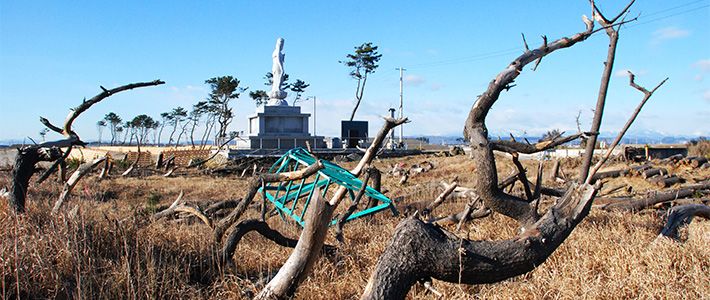
Rebuilding a Region: Tōhoku Five Years Later
Rehousing in Tōhoku: The Two Faces of Reconstruction
Society- English
- 日本語
- 简体字
- 繁體字
- Français
- Español
- العربية
- Русский
In February this year, the Sendai 3.11 Memorial Community Center opened in the brand-new Arai Station building at the eastern terminus of the Sendai subway’s Tōzai Line, completed just last December. Added at the last minute to existing station plans (the Tōzai Line had been under construction since 2006), the Memorial Center features photo exhibits and other information about the impact of the March 2011 tsunami and the progress of reconstruction. I found it bustling with visitors from nearby and farther afield, even on a weekday.
From Arai Station, I drive four kilometers toward the coast under a blue winter sky, arriving at the old Arahama district in Wakabayashi ward. Once a community of about 2,700 homes nestled between a patchwork of fields and the seashore, the district is now a barren waste. The only major structure that remains standing is the abandoned ruin of Arahama Elementary School, which was flooded almost to the third floor. I watch dump trucks come and go in the distance, laying the foundation for development on higher ground.
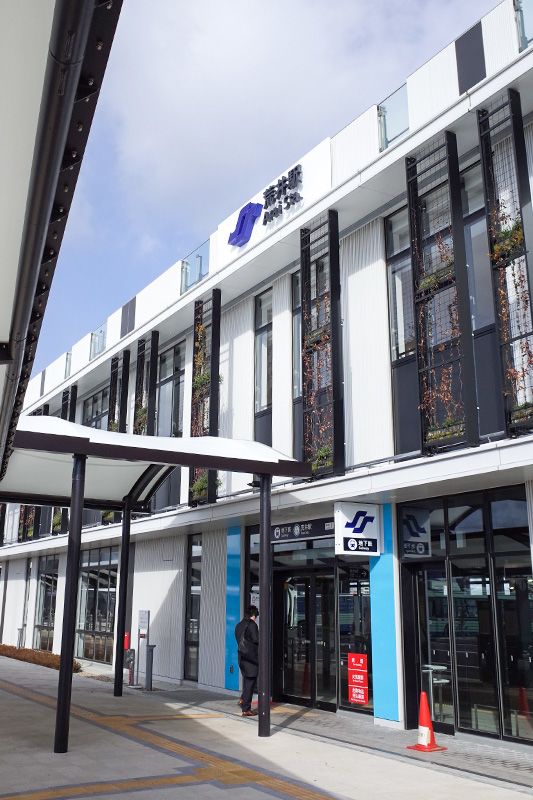 Arai Station, the eastern terminus of the Sendai subway’s Tōzai Line, opened last December, more than 20 years after plans were approved. The area around the station is undergoing redevelopment.
Arai Station, the eastern terminus of the Sendai subway’s Tōzai Line, opened last December, more than 20 years after plans were approved. The area around the station is undergoing redevelopment.
The 2011 earthquake and tsunami claimed more than 900 lives within the Sendai city limits, most of them residents of Wakabayashi ward and neighboring Miyagino ward. Now the low-lying coastal areas have been designated tsunami hazard zones and placed off-limits for residential construction. The city is in the process of “collectively relocating” the former inhabitants of those neighborhoods to new housing on higher ground, much of it concentrated in the area around the newly built Arai Station.
Arai Station is just a 10-minute walk from the large temporary housing facility where thousands of homeless Arahama residents lived while awaiting resettlement. The rows and rows of prefab structures are still standing, but they are mostly empty now, as is the large parking lot on the site. Many of the occupants have moved into one of the nearby public housing developments for disaster victims, while others have paid out of their own pockets to build new single-family homes on lots acquired and developed by the city.
Sendai has recovered quickly compared to many tsunami-stricken communities in the region. A major regional city with a population of more than a million, Sendai has the advantages of a solid tax base and a highly developed urban and residential infrastructure. The city government drew up a five-year timetable for the rehousing component of its disaster reconstruction plan, and local officials say that they are more or less on schedule.
Even so, it was a long wait for people like 73-year-old Daigaku Kumiko. She and her husband spent four and a half years in disaster shelters and temporary housing after their home on Fukanuma Beach in Arahama was swept out to sea. During that time they sold their land and somehow managed to pay off the mortgage. Finally, last November, they were able to move into a new subsidized single-family home on one of the sites the city has set aside for residential development in the area around Arai Station.
“After all that time in cramped, dark quarters, we were finally able to move into a real house that we can call our own,” she says with a sigh of relief. They have to pay ¥30,000 a month in rent, but they manage to get by on their pension benefits and the money her husband makes working part-time in Tokyo.
“It’s hard to make ends meet,” she says, “but I have a lot of friends here. I’m looking forward to getting on with my life and enjoying my hobbies—cooking and Nagoya harp.”
Not far away is the Arai Higashi municipal housing development, a large two-building complex built to house about 300 families. Among the occupants is Ōhashi Kimio (72), head of the development’s neighborhood association, who lost his Arahama home of more than 30 years to the tsunami. He spent the first few weeks after the disaster moving from shelter to shelter, then lived in temporary housing in Wakabayashi ward for about three years before finally moving into the complex two years ago.
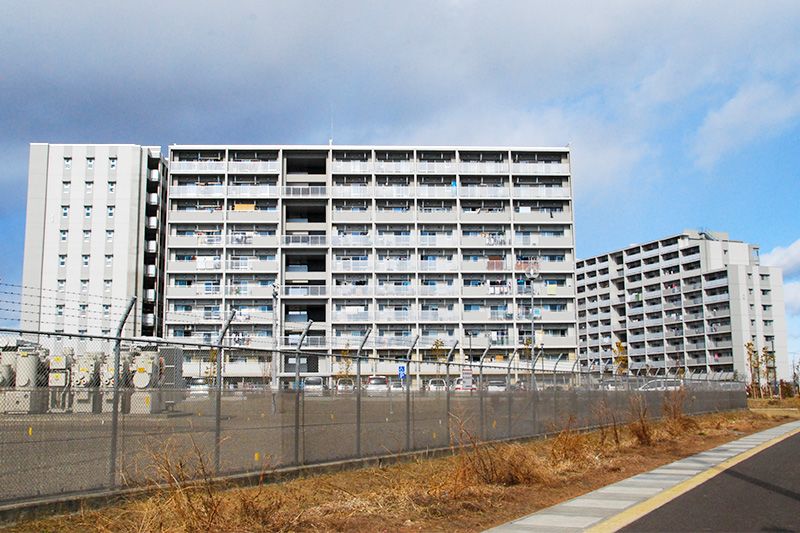 Sendai’s Arai Higashi municipal housing complex has become home to many former residents of Arahama, an outlying coastal community that was all but obliterated by the Great East Japan Earthquake.
Sendai’s Arai Higashi municipal housing complex has become home to many former residents of Arahama, an outlying coastal community that was all but obliterated by the Great East Japan Earthquake.
The opening of the Tōzai Line has been a huge plus for this neighborhood,” says Ōhashi. “It’s getting more convenient all the time. Some of the tenants have moved here from temporary housing in Onagawa and Ishinomaki.”
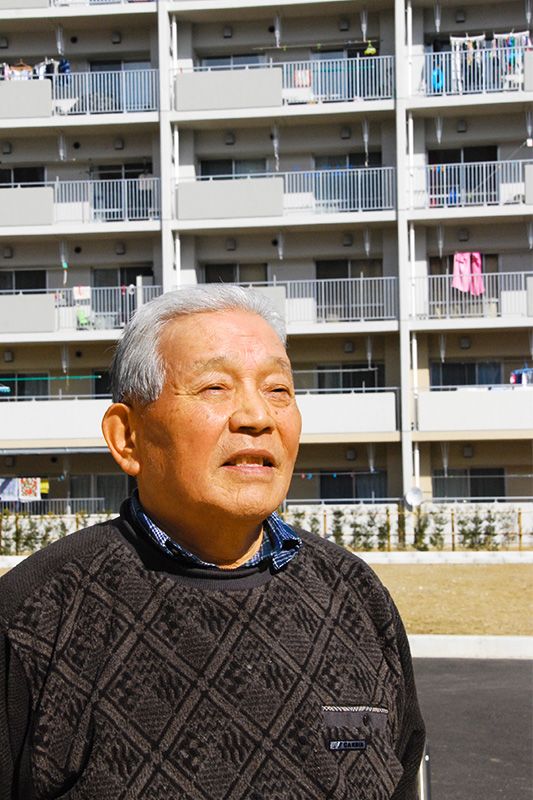 Ōhashi Kimio, head of the neighborhood association at the new Arai Higashi municipal housing complex for disaster victims, spends most of his daytime hours at the development’s community center. “This is the heart of the community,” he says.
Ōhashi Kimio, head of the neighborhood association at the new Arai Higashi municipal housing complex for disaster victims, spends most of his daytime hours at the development’s community center. “This is the heart of the community,” he says.
“I like to spend my time here exercising and socializing with the other tenants.”
In fact, Sendai has become something of a magnet for survivors from the surrounding area, including those frustrated with the pace of recovery in their own communities. With many Sendai natives still reeling from the loss of friends, loved ones, and property, one occasionally hears complaints that this influx is pushing up the cost of living and inflating real estate prices. But Ōhashi stresses that all the tenants of the Arai Higashi development are displaced survivors like himself who want nothing more than a place where they can live in peace and quiet after their harrowing experience.
“There are a lot of people here in their eighties and nineties," says Ōhashi. "I do my best to reach out and keep an eye on them.” Ōhashi understands that elderly people uprooted from their homes and communities are at high risk. “Solitary death was a big issue in the temporary housing facility, and unfortunately, we've had a few cases here as well.” In view of the high concentration of elderly residents, Ōhashi has asked the city to install automated external defibrillators.
From the housing complex, I head back to the central business district around Arai Station, where redevelopment is proceeding apace. One of the district's attractions is Moroya Farm Kitchen, a farm-to-table restaurant established in 2000 by a family that has lived and farmed in this district for nine generations. The restaurant operated inside the family home for 15 years, then moved into one of the new commercial buildings near Arai Station when the Tōzai Line opened. Its vegetarian-oriented cooking, highlighting homegrown seasonal heirloom vegetables, is popular with locals and visitors alike.
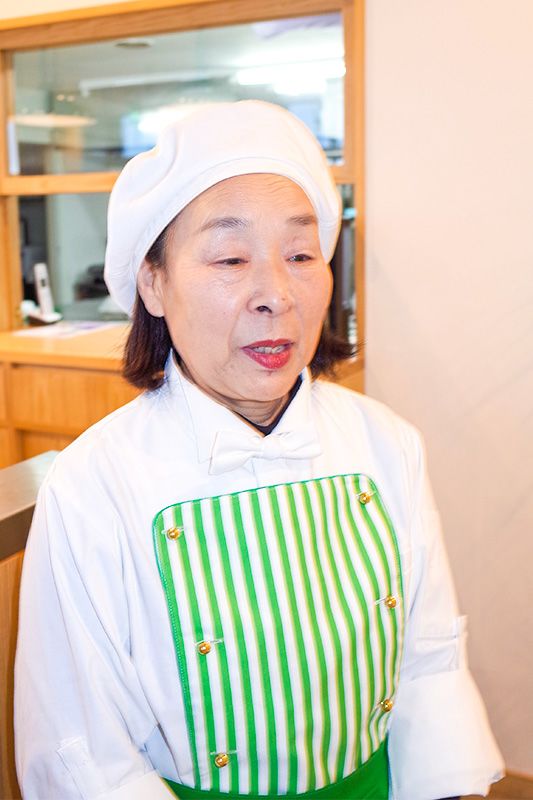 Kayaba Ichiko of the Moroya Farm Kitchen explains her pleasure at the restaurant’s role in helping along development of the station area.
Kayaba Ichiko of the Moroya Farm Kitchen explains her pleasure at the restaurant’s role in helping along development of the station area.
“We leverage our unique strengths as a producer and try to let the natural good taste of the ingredients come through,” explains spokeswoman Kayaba Ichiko (67). “We think about the menu before we even begin planting. We grow 150 different vegetables, all suited to specific dishes.”
Although the tsunami left the family home undamaged, it flooded half of the farm with seawater. It took a full year to remove the debris, rehabilitate the soil, and render the fields fit for cultivation again. As a result, the restaurant was forced to close its doors temporarily. It reopened a few months later, however, with the help of friends who lent the owners farmland where they could continue to grow their vegetables.
According to Kayaba, business has increased five-fold since the restaurant moved to its new location. “The new subway line is changing the face of this district,” she said. “We’re hoping we can become a kind of meeting place for local residents and visitors from other regions.”
I toured the coast of Miyagi Prefecture on March 22, 2011, just 11 days after the earthquake and tsunami. Heaps of rubble and wreckage littered the shoreline as far as the eye could see. Although the tsunami itself spared central Sendai, the entire city was paralyzed, and the Sendai Station area was a scene of utter chaos. My return visit almost five years later revealed to me a community that, while still facing formidable challenges, is well on its way to recovery.
Rehousing Issues Accelerate Exodus
But Sendai, the Tōhoku region’s largest urban center, is a “designated city” with a high degree of administrative and fiscal autonomy. The progress of recovery and reconstruction here is by no means representative of the stricken region as a whole.
The reconstruction gap between Sendai and other municipalities in Miyagi Prefecture is particularly evident in the area of rehousing—the most urgent priority for post-disaster recovery. According to the Miyagi Prefectural Government, 27% of the prefab temporary housing units built in Sendai to shelter homeless tsunami survivors were still occupied as of January 28, 2016. In the coastal communities of Ishinomaki, Kesennuma, Onagawa, and Minamisanriku, on the other hand, the figures were 58%, 65%, 76%, and 64%, respectively.
Not surprisingly, regional population trends mirror this recovery gap. The results of the 2015 Census reveal that Miyagi Prefecture’s tsunami-stricken coastal communities have suffered a sharp drop in population since the last census, in 2010. Onagawa experienced a 37% decline. The population of Minamisanriku fell by 29% and that of Yamamoto by 26%. Sendai’s population, meanwhile, grew by 3.5% to hit an all-time high of 1.08 million.
One of the biggest losers by both measures is Onagawa, where three-quarters of the temporary housing units built in the wake of the disaster are still occupied, and the population has dropped from about 10,000 to fewer than 7,000. I have visited this community periodically since the 2011 disaster and have reported on encouraging developments in port and road repair, commercial redevelopment around Onagawa Station, and the recovery of the fishing and seafood processing industries, on which the town’s economy relies. But I found these housing and population figures deeply disturbing. I decided it was time to revisit Onagawa and assess the progress of recovery and rehousing for myself.
Plenty of Shopping, Nowhere to Live
When I visited Onagawa in June 2015, three months after the opening of the relocated Onagawa Station (the original station was destroyed in the tsunami), redevelopment of the town center was progressing rapidly, and that progress has continued. Apart from the station building itself, the centerpiece of the project is a shopping street called Seapal Pia Onagawa, located between the station and the port. Restaurants, boutiques, and a community center occupy quaint, single-story buildings on either side of a wide walkway, where shoppers stroll at their leisure. The number of buildings and shops has increased since the opening last December, and pedestrian traffic seems to have picked up as well.
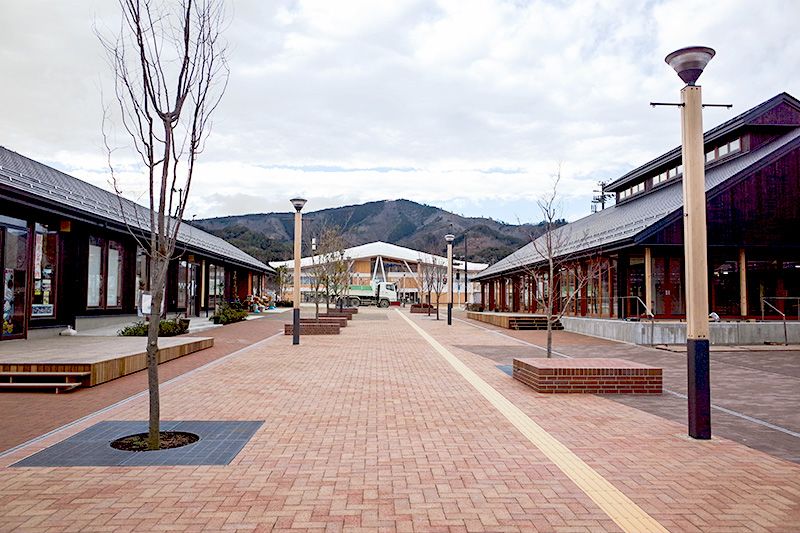 The completion of Seapal Pia shopping street near Onagawa Station has given the town center a major face-lift.
The completion of Seapal Pia shopping street near Onagawa Station has given the town center a major face-lift.
Amid a sprinkling of snow, I proceed from the station to a large tract of high ground further inland, which was cleared and set aside for rehousing after the tsunami. This is the site of a large group of temporary units, as well as a new public housing development. Beyond these buildings, construction vehicles are busy preparing the foundations for additional public housing. It has been an excruciatingly slow process.
At the End of Their Rope
Since July 2015, Shizukuishi Mitsuko (86) has been living by herself in a new public housing unit built on the former site of the Onagawa municipal athletic stadium. Born and raised in this town, she lost her home to the March 2011 tsunami, took refuge in an emergency shelter, and spent three grueling years in temporary housing. But now all that is behind her, she says, and she is making the most of each new day.
“About half of the people in my old neighborhood were killed in the tsunami,” she says. “And a lot of the survivors have gone elsewhere. So I don’t have that many people I can talk to nowadays. But the building is solid and comfortable, and I've settled in. I just want to live out my days in peace and good health.”
Meanwhile, however, roughly 2,000 Onagawa citizens are still living in cramped prefab temporary housing units. “It’s really tough,” says Kimura Satoru (66). “It’s freezing in the winter and sweltering in the summer, and that takes a toll on your health. How long are we supposed to put up with it?”
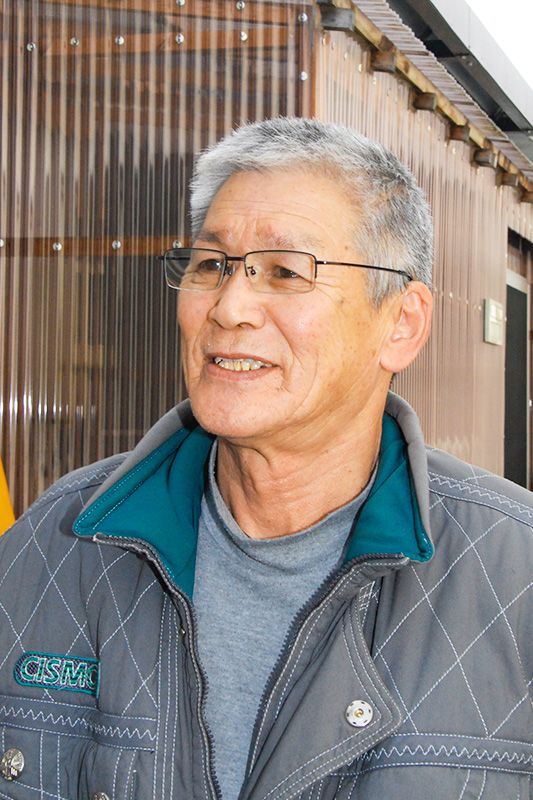 Kimura Satoru, who lives with his son and grandson in a two-room temporary housing unit, takes responsibility for the housework. “I make my grandson’s lunch every day,” he says.
Kimura Satoru, who lives with his son and grandson in a two-room temporary housing unit, takes responsibility for the housework. “I make my grandson’s lunch every day,” he says.
Kimura, his son, and his middle-school-aged grandson share a tiny two-room unit. “It’s much too small for three people,” he says, “and the walls are so thin, there’s no privacy at all. It really gets you down after a while.” Initially scheduled to move into public housing in April, the Kimuras were informed that they would have to wait another year owing to construction delays.
The tsunami claimed Kimura’s wife as well as his home. Kimura himself escaped death only because he was out visiting a friend at the time. From the emergency shelter set up on the grounds of the Onagawa Nuclear Power Station, the three survivors moved in with Kimura’s married daughter in Yamagata Prefecture, where they lived for three years. But Kimura, who had worked for years as a fisherman and sailor, missed his home by the sea, and they returned to Onagawa in 2014.
While temporary housing is provided free of charge to homeless disaster victims, public housing in Onagawa costs tenants anywhere from ¥10,000 to ¥20,000 a month. Still, most consider it a small price to pay to escape the purgatory of temporary housing.
“We understand that it takes time to recover from a disaster on this scale,” says Kimura. “But the sooner we get a place of our own, where we can settle down, the sooner we can stop relying on the government. That’s all we ask.”
Formidable Challenges
A 56-year-old woman living in a nearby temporary unit echoes these sentiments.
“We had our children to think about, so we planned to use our own money to rebuild on one of the residential sites being developed by the local government. But now they’re telling us it won’t be ready until the spring of 2018! There’s no telling what land prices will be like by then, so we can’t really plan financially. We never imagined it would take more than five years to get out of here. A lot of our neighbors have given up and moved in with their children in Sendai or Ishinomaki or have left here for communities that are making faster progress building new homes.”
On each of my five visits to Onagawa since the tsunami, I have been impressed by the local officials’ commitment to rehousing the disaster victims. There is no question that this is their top priority. But Onagawa faces monumental challenges. The tsunami destroyed most of the town, including its central business and residential districts. And the area has very little high ground that is suitable for residential development. Those charged with preparing the building sites have run into solid bedrock, which has caused long construction delays. Even acquiring the land for development has been an ordeal, since it involves identifying and contacting numerous owners scattered around the country to secure property rights.
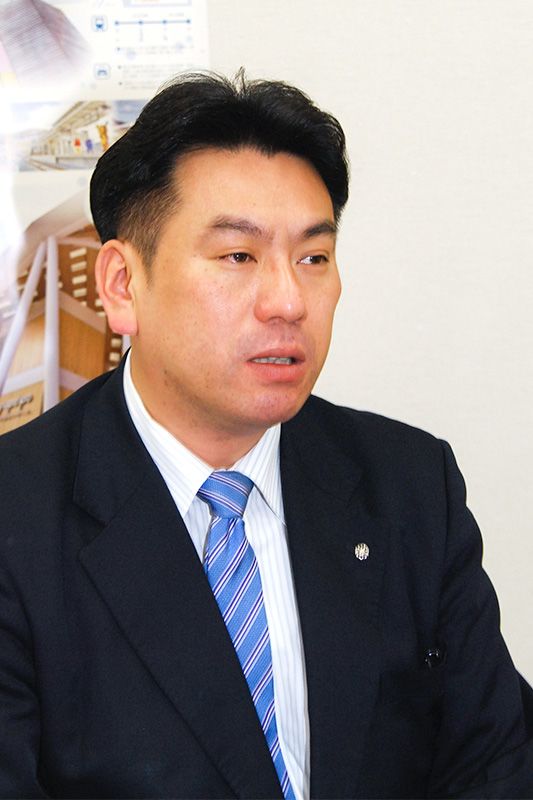 Onagawa Mayor Suda Yoshiaki: “However tough things get, I’m going to stand by our citizens, stay positive, and tackle each obstacle aggressively.”
Onagawa Mayor Suda Yoshiaki: “However tough things get, I’m going to stand by our citizens, stay positive, and tackle each obstacle aggressively.”
The municipal government expects to complete 28% of the public housing slated for construction in the town’s central districts (excluding islands and peninsulas) by the end of March 2016. It hopes to have completed all units by the end of March 2018. But how many of the town’s displaced can wait that long?
“We understood from the outset that recovery would take a long time, and we were resigned to some decline in the local population,” says Onagawa Mayor Suda Yoshiaki. “But securing decent housing for our citizens remains the top priority. We’ve brought in special blasting equipment to remove the rock and speed up excavation, and we’re determined to complete construction as soon as we possibly can.”
Unlike Sendai, the region’s smaller communities have struggled with depopulation and economic decline for years, and the 2011 disaster has accelerated the exodus. Still, the victims expect action, and it is the government’s duty to respond. Mayor Suda says he is determined to make Onagawa “a town ready to take on one new challenge after another.” But the first step, as he knows, is making sure that its citizens have somewhere to live.
(Originally written in Japanese. Article photos courtesy of the author. Banner photo: A seaside monument to the victims of the March 2011 tsunami is virtually all that remains of the Arahama district of Sendai, Miyagi Prefecture.)Great East Japan Earthquake Onagawa tsunami Sendai reconstruction 3/11 temporary housing public housing